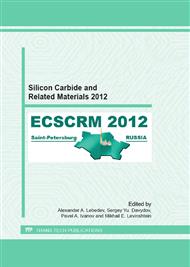p.613
p.617
p.621
p.625
p.629
p.633
p.637
p.641
p.645
Formation of Epitaxial Defects by Threading Screw Dislocations with a Morphological Feature at the Surface of 4º Off-Axis 4H-SiC Substrates
Abstract:
In this paper, we present the formation of extended epitaxial defects, such as carrot defects, from threading screw dislocations (TSDs) with a morphological feature at the surface of the substrates. It was confirmed using highly sensitive surface observation, atomic force microscopy (AFM) and KOH etching that the surface roughness around a TSD was observed as the morphological feature and TSDs with such a morphological feature formed extended epitaxial defects with high frequency of appearance compared to usual TSDs without any features. The density of TSDs with such morphological feature depended on the polishing methods. Furthermore, we observed that the formation and shapes of extended defects from TSDs with such morphological feature were affected by step-bunching at the surface of the epilayers.
Info:
Periodical:
Pages:
629-632
Citation:
Online since:
January 2013
Keywords:
Price:
Сopyright:
© 2013 Trans Tech Publications Ltd. All Rights Reserved
Share:
Citation:


